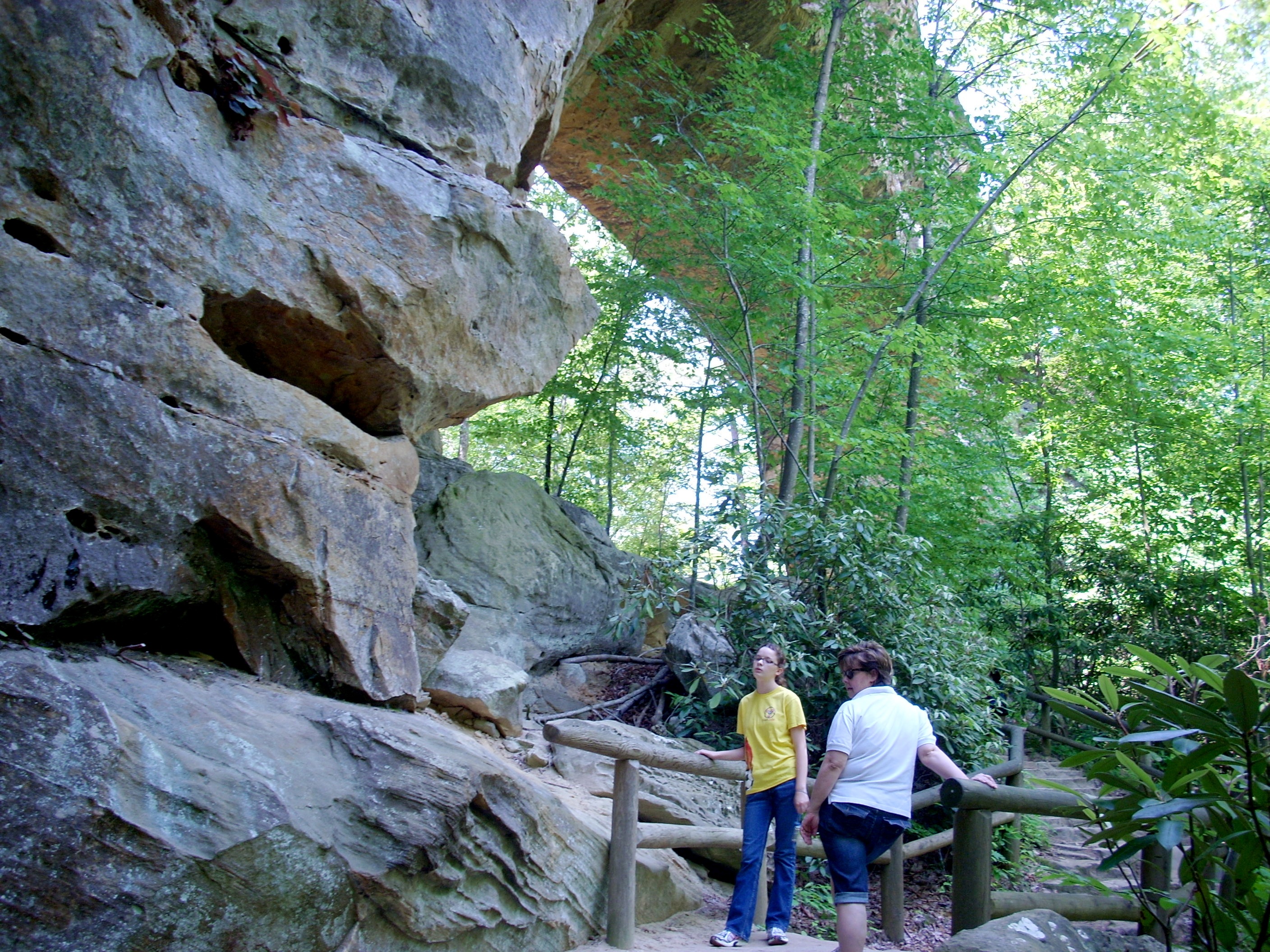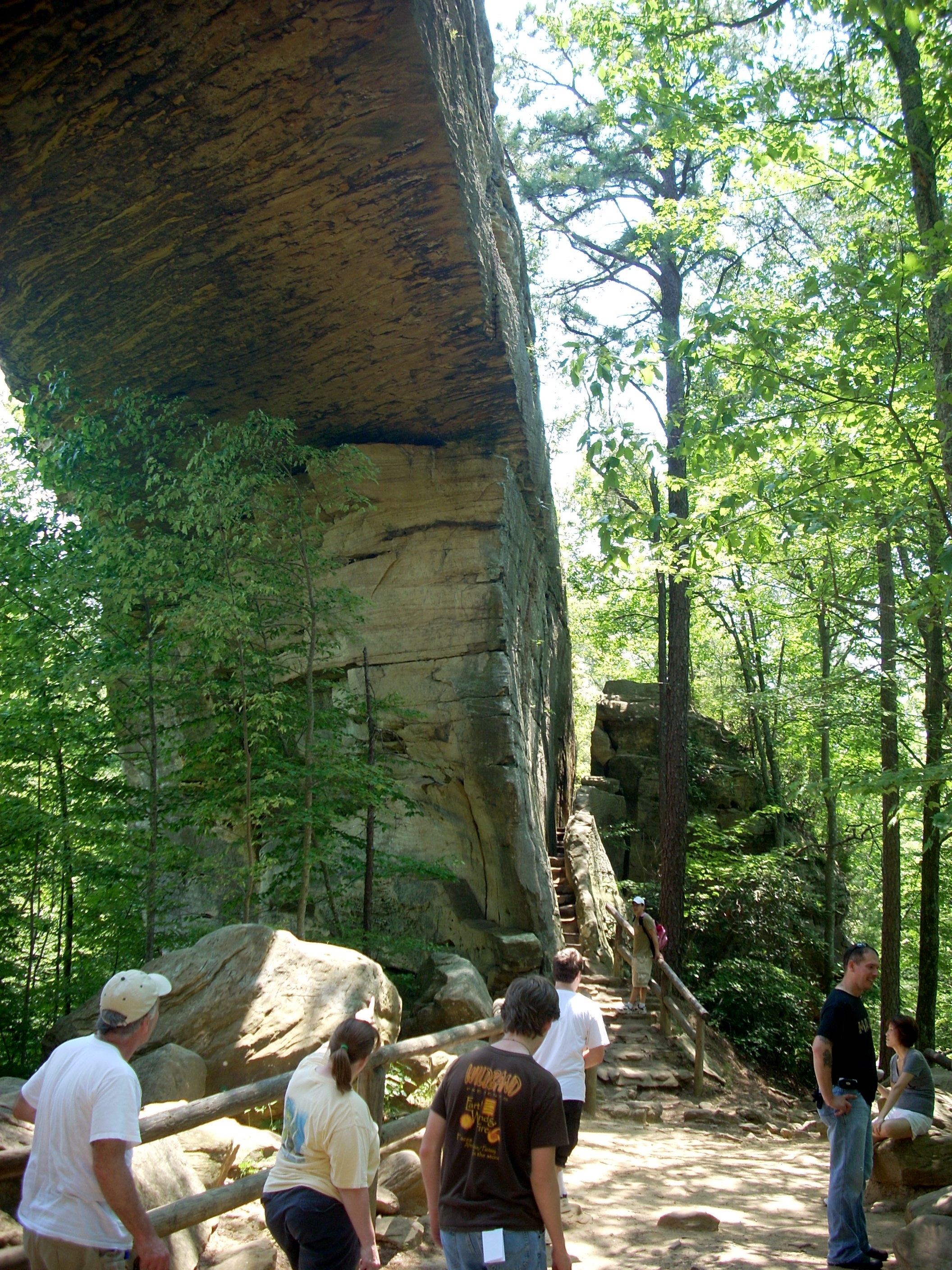The Balanced Rock Loop is the introductory hike at Natural Bridge. You go up Original Trail and come down via Balanced Rock Trail. The Original Trail was laid out in 1895 when the railroad developed the park as a tourist attraction to encourage people to ride passenger trains. Every Friday, Saturday and Sunday trains brought visitors out from Lexington, where they could either spend the day and return by train that night, or they could stay overnight in cabins or the main lodge. From 1895 until 1925 the Original Trail was the only trail officially maintained, although people would wander around the ridges on their own and eventually created other trails. The current Original Trail follows the exact same route laid out in 1895, and the steps, gazebos and railings are in the same place, but by 1930 these features had begun to deteriorate. They were totally redone by the Civilian Conservation Corps. The stairs you see today, such as the ones pictured at right, were carefully fitted by the CCC, and like many other features of the park, stand today as a monument to those men. |
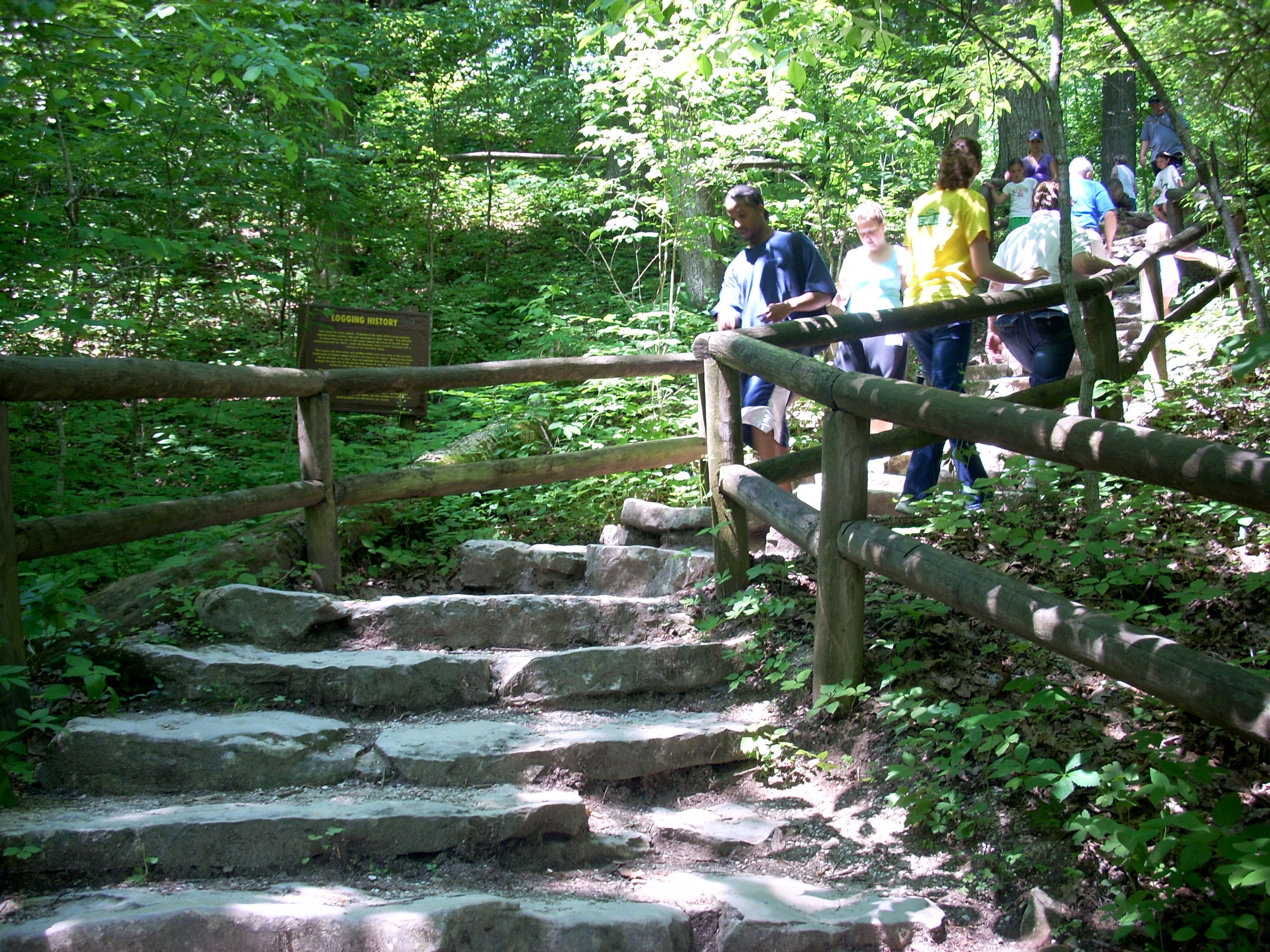 |
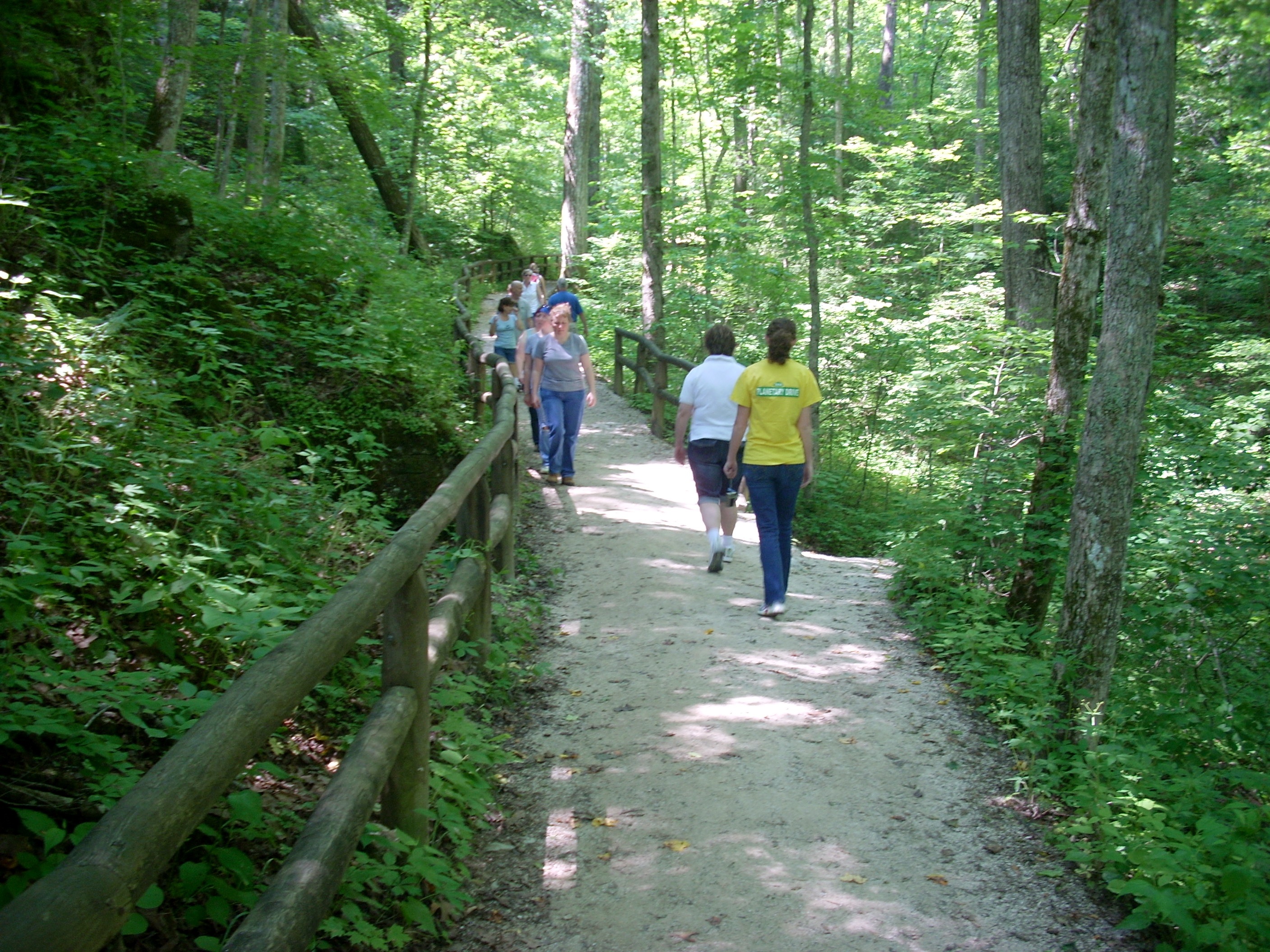 |
The Original Trail seems very civilized today. 21st Century hikers in their Vibram sole hiking boots like their trails long and challenging. But back in 1895 the idea of going to the wilderness for recreation was just beginning. People from cities did not own special hiking boots or clothes. We have hundreds of photos of women hiking up to the bridge in dresses and regular shoes, while the men accompanying them were often in coats and ties. People from the cities did not do enough hiking to be in good condition, so their hike up to the Bridge was very leisurely. They would often carry a picnic basket, stopping at each bench and gazebo to rest, talk and admire the scenery while having a glass of wine and a chicken leg. The lodge restaurant packed picnic baskets with wine, cheese, bread, fried chicken and cloth napkins for 75 cents, plus a 25 cent deposit you got back when you returned the basket with its napkins, wine glasses, bottle and knife. |
| The gazebos have been rerooved several times since, but the bases are the ones built by the CCC. You will notice a common architectural style, but each gazebo is slightly different to fit into the particular location. However, the views from the gazebos are not as expansive as they once were. They were carefully located where hikers could sit in them and see out across the valley or look up at a spectacular rock formation. But this land had been recently timbered and the trees had just begun to grow back. In the century since, the trees have grown huge and the understory, mostly rhododendron and mountain laurel, has filled in the gaps. As a result, there is no gazebo where you can see very far except for the pavilion up on top. So today, the gazebos allow us to enjoy the cool shade of the forest, admire the deep green foliage, and try to picture Victorian ladies in full skirts on the trail. |
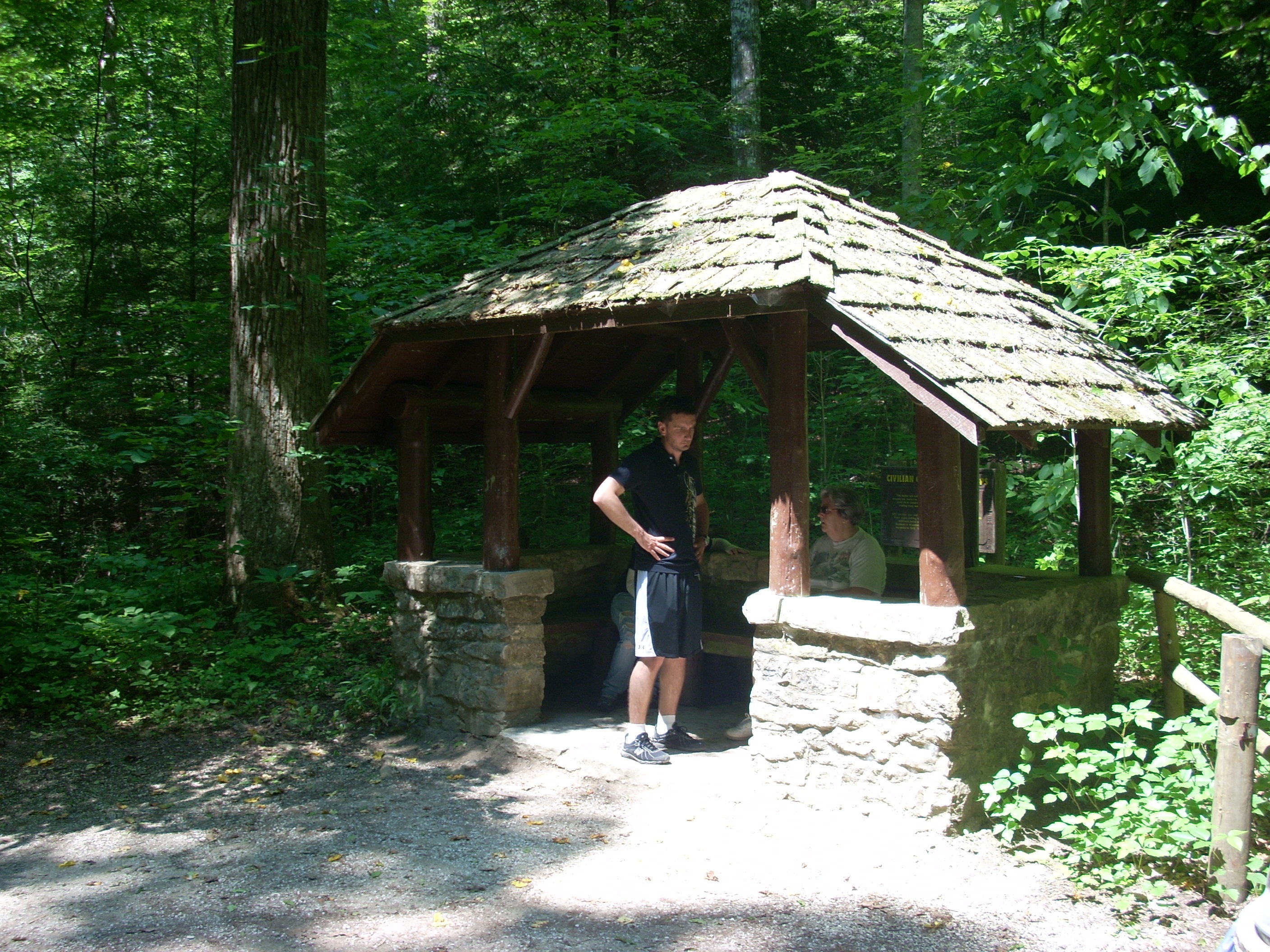 |
 |
On the left, only a few feet from the trail but fenced off, is this cave opening. Until recently, this was another of the park's favorite attractions, especially for teenagers. This is the upper opening into the cave that slopes downhill and widens into a large opening along the Balanced Rock Trail. We'll see the other end, also now gated off, as we complete the loop. The park closed off the cave because the Kentucky Brown Bat population that inhabits the cave has become endangered by White Nose Disease. The bat population here in Natural Bridge remains healthy, but rangers feared people continually passing through the cave would bring the disease in on boots or clothing, since caving is popular and many people visit other caves in Kentucky and Indiana. This is not a large cave compared to Mammoth, Diamond, Onyx, Carter, Squire Boone or Marengo, the other caves popular with people in this area. A person can lower himself through this opening, walk bent over for about five minutes, then straighten up and walk to the lower end in about 15 minutes. In 1895 the railroad lighted the cave and advertised it back in Lexington, Louisville and Cincinnati as a major attraction. The lights were removed in 1962 and rangers led tours through with flashlights. After those stopped, people could still use their own flashlights. This is not a "show cave," with fancy stalagtites, stalagmites, bacon rinds, popcorn, drinking straws and other typical cave formations. The walls and roof of this cave are mud with bats the only hanging ornament. |
| In between the gazebos, benches like this are placed in scenic places. They are usually near informational plaques like this one, which educate people about the history, geology, botany or zoology of the park. On weekdays, a person willing to sit on one of these benches for about 15 minutes can see birds, snakes, lizards, and other animals emerge and scamper across the trail or the forest floor. On weekends, however, there are enough hikers that the animals retreat far back from the trail. |
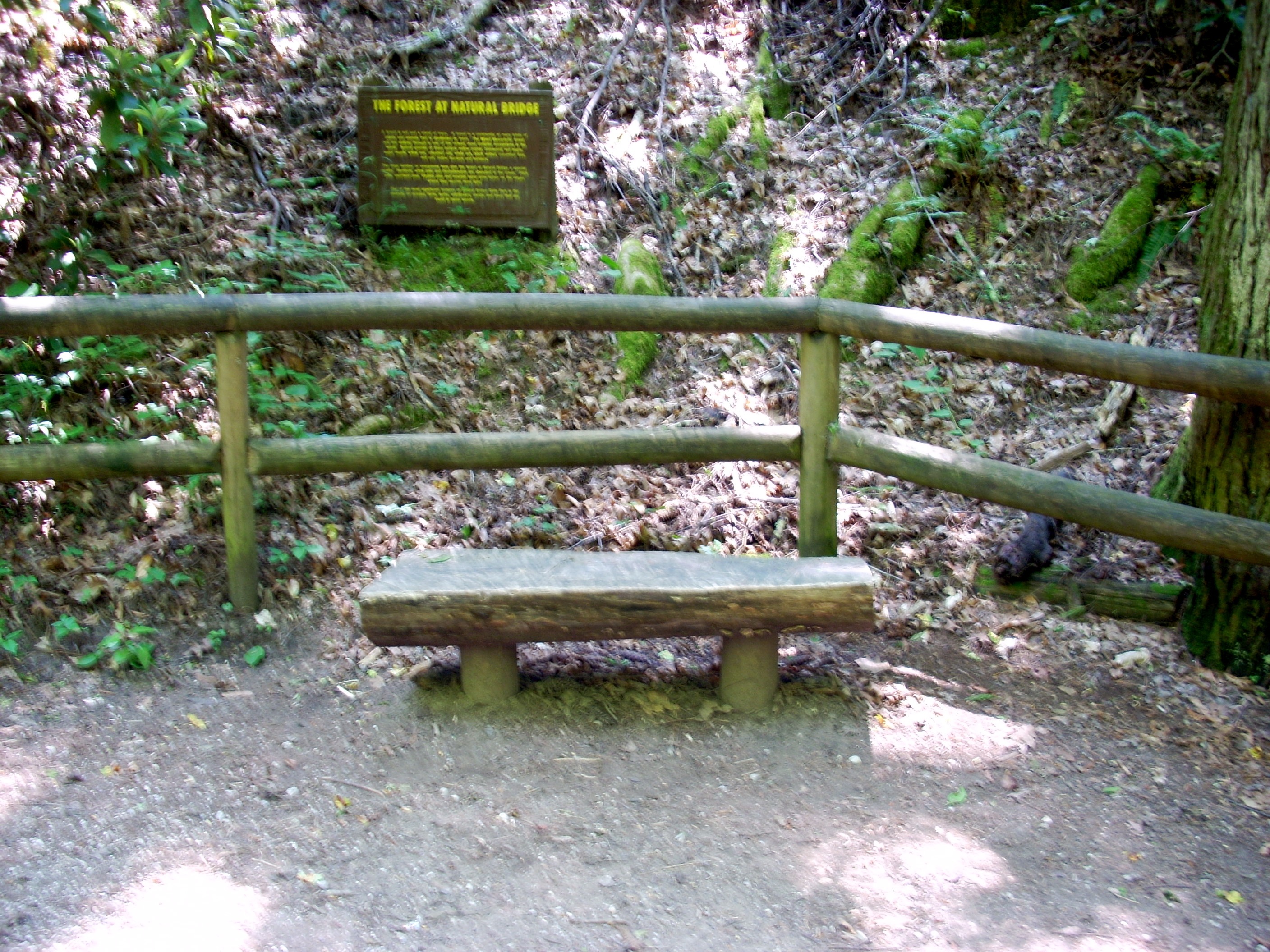 |
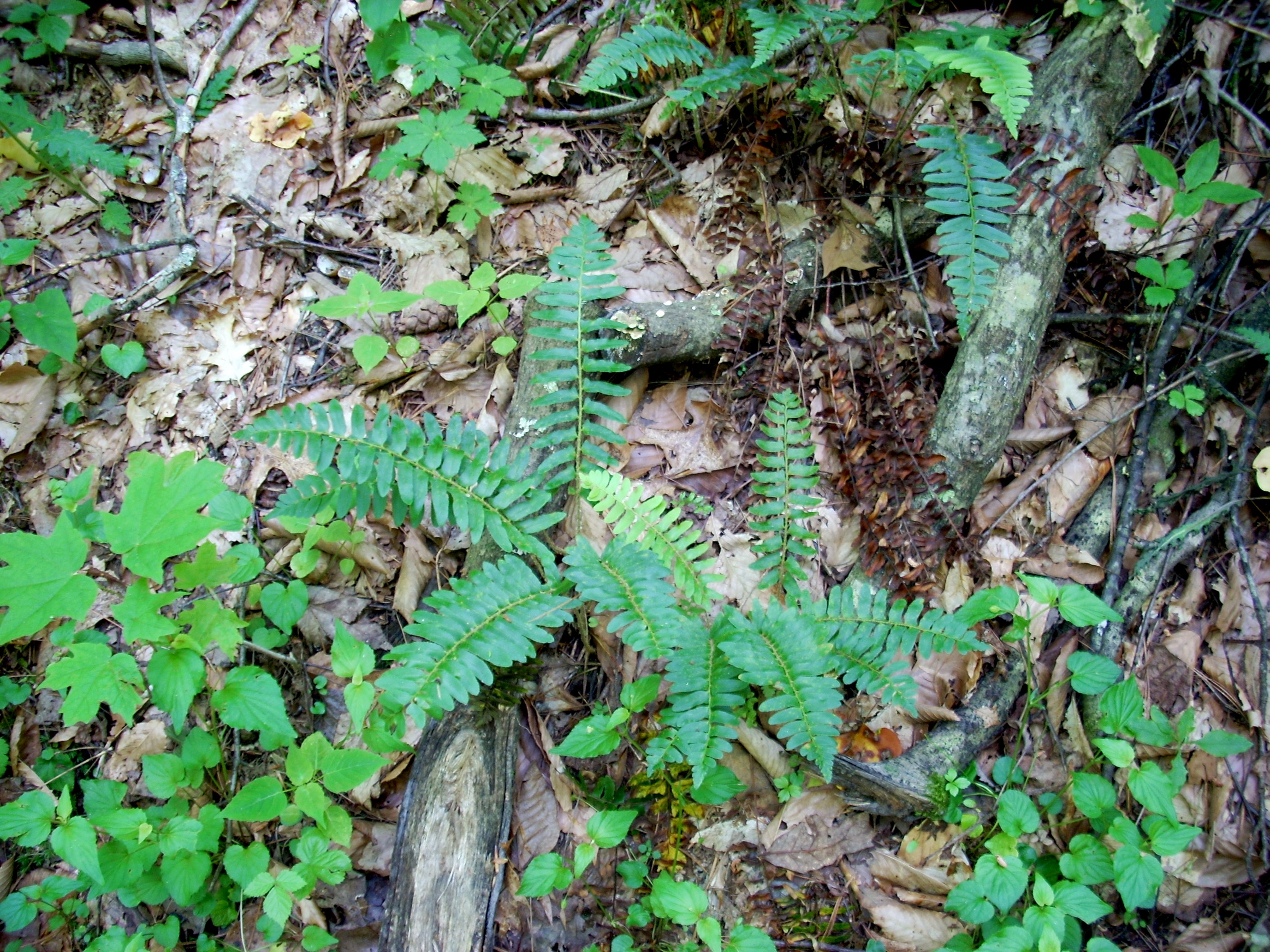 |
A teacher could teach an entire unit on Ferns here. Shown at left is a cluster of Ebony Spleenwort, the long deep brown stem with the rows of waxy green leaves extending right and left. Many Pteridologists (specialists in Ferns) believe this is the most beautiful of the ferns, or at least one of the two or three most beautiful. Ebony Spleenwort is the ancestor of the Gymnosperms, the first trees. Ebony Spleenworts still use spores to reproduce, but their spores are the most advanced of all ferns, and led to the evolution of seeds, which allowed for the Gymnosperms. The stems of Ebony Spleenwort are also unique in that they incorporated lignin (which allowed the construction of stiff stems). They were the first plants to do this. This allowed Spleenworts in the Age of the Dinosaurs to grow to towering heights and evolve into the Gymnosperms (pine trees). During the reproductive seasons you can simply turn these fern leaves over and see the spores lined up on the bottom. The first Gymnosperms retained this exposed style. The very word Gymnosperm means "naked seed." |
| This is your view of the Bridge as you finally reach the top of the hill. Battleship Rock Trail comes in from the right just at the bottom of the bridge. |
|
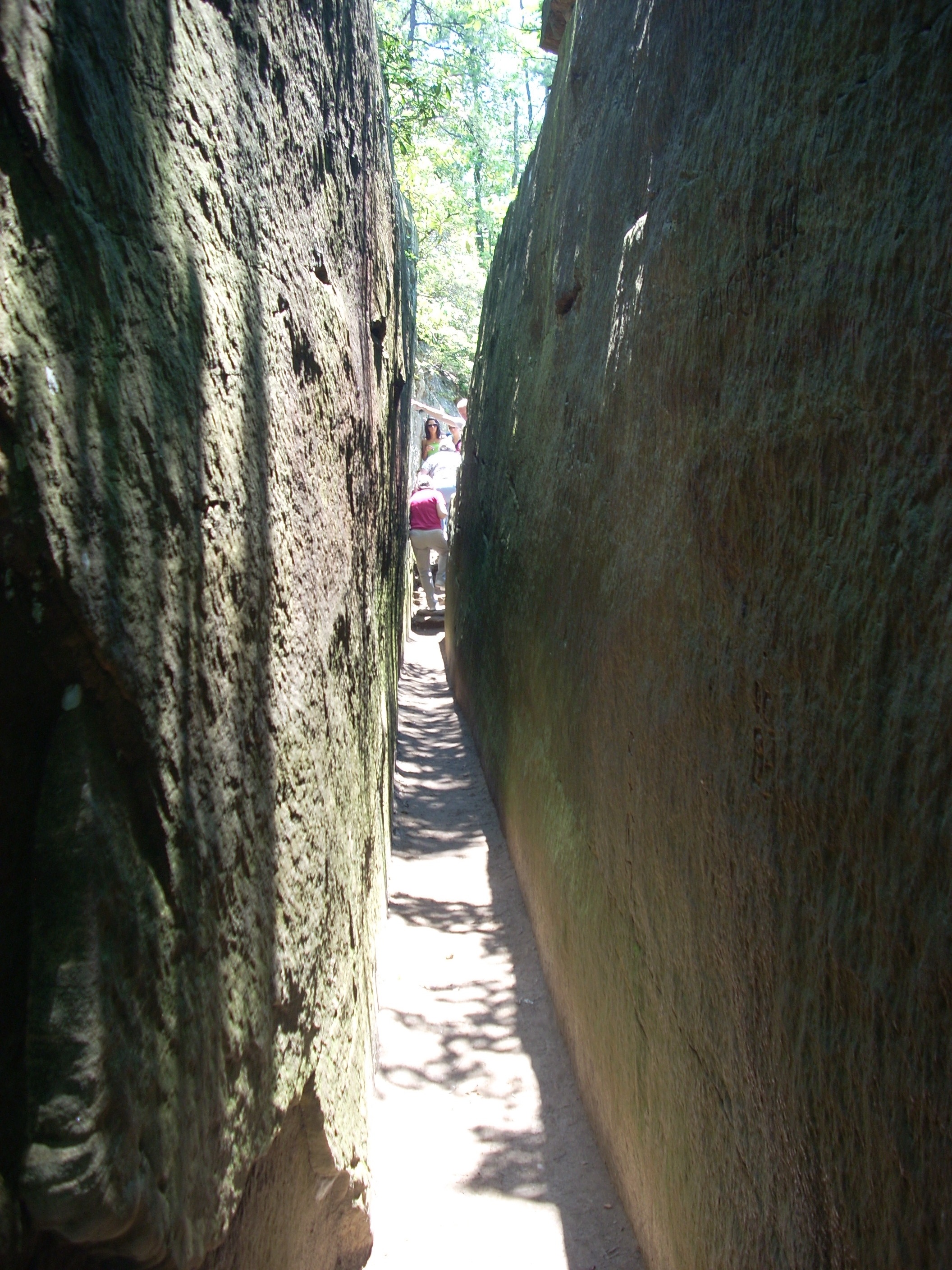 |
Fat Man's Misery is one of the park's most famous features. A narrow passageway through the base of Natural Bridge, you must get through this to get to the top of the bridge and for anyone overweight it is not easy. It's not quite as narrow as it looks in this photo, but it is definitely a tight squeeze. There are some people who simply cannot wrestle their way through,even if they turn sideways or get a push from their friends. |
| Heading down Balanced Rock Trail, you pass through an extensive stand of Mountain Laurel. The Red River Gorge, which includes Natural Bridge, and Pine Mountain, in Southeastern Kentucky, contain more Mountain Laurel, and larger Mountain Laurel, than any other place on Earth. |
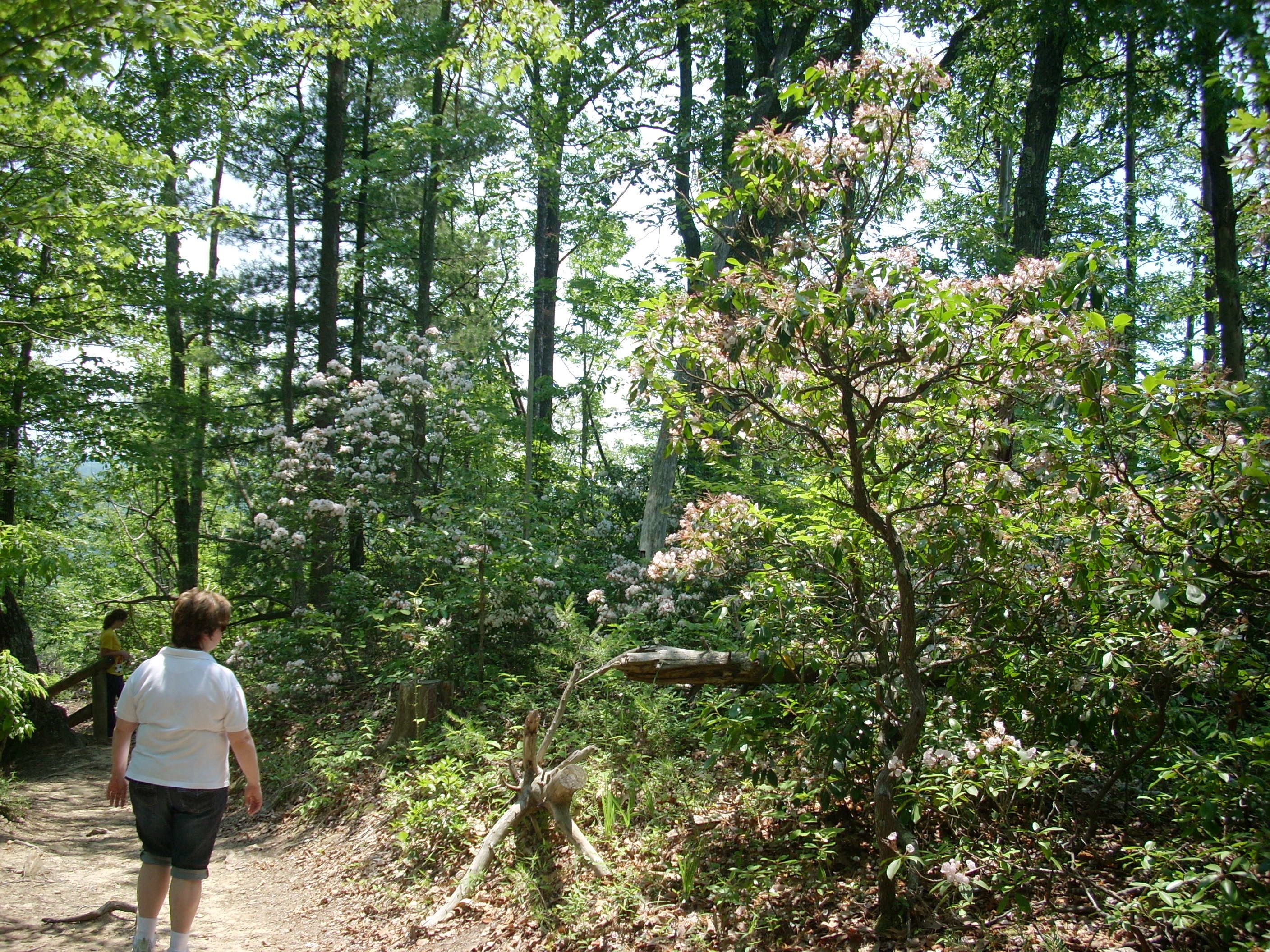 |
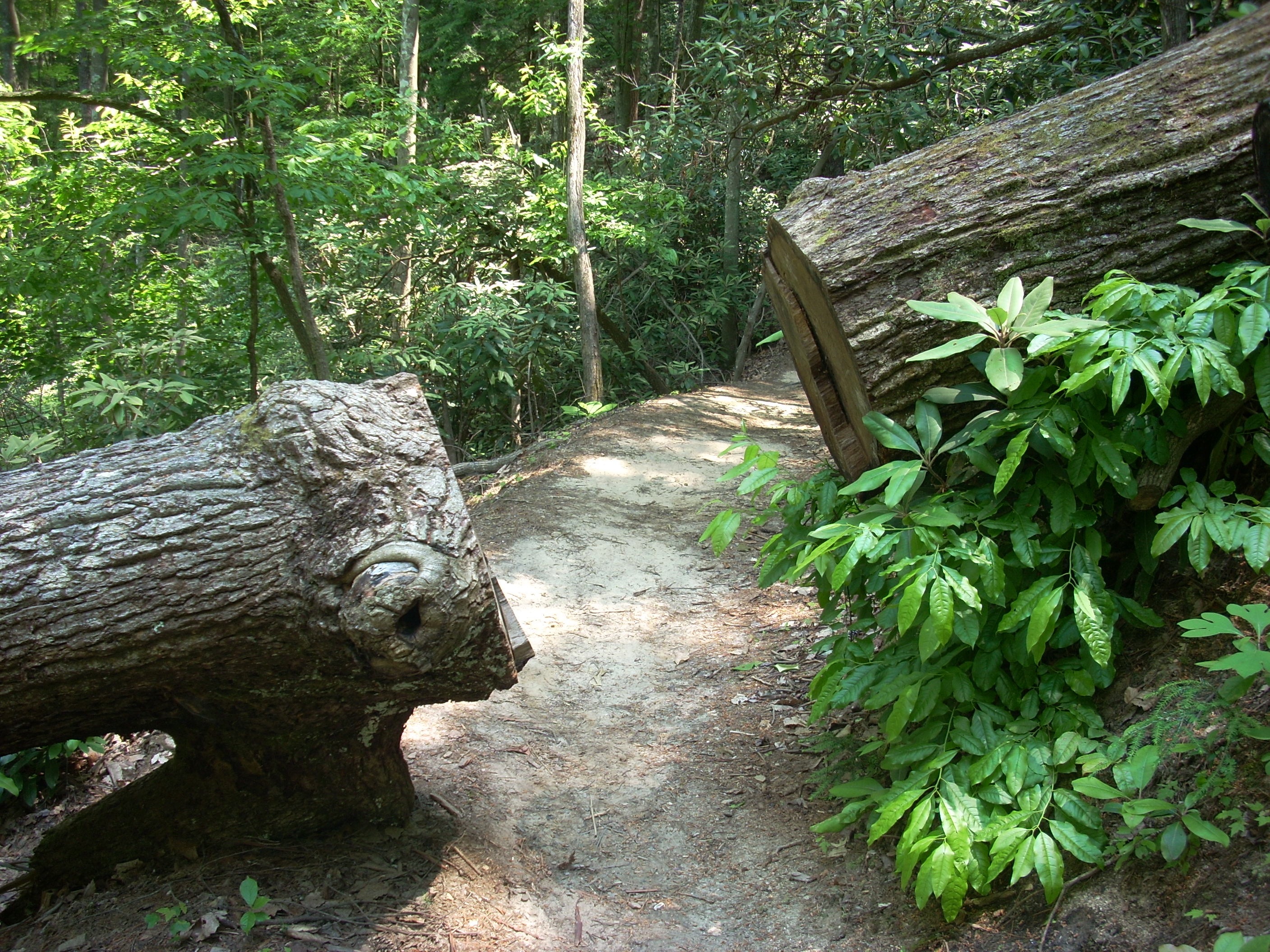 |
The ridge containing Natural Bridge is high, exposed and faces West, leaving it open to high winds and lightning during storms. Large trees are often blown down or struck by lightning. Trail crews find it easier to cut through the trees than to move them. This tree is high on the ridge along Balanced Rock Trail. |
| As the Balanced Rock Trail begins descending along the shoulder of the ridge, it enters deep forest with Rhododendron and Mountain Laurel as understory trees and a canopy of Oak and Hickory. From the beginning of the trail where it branches off from Sand Gap Trail 50 yards past the Pavilion, Balanced Rock Trail is a steady downhill grade. |
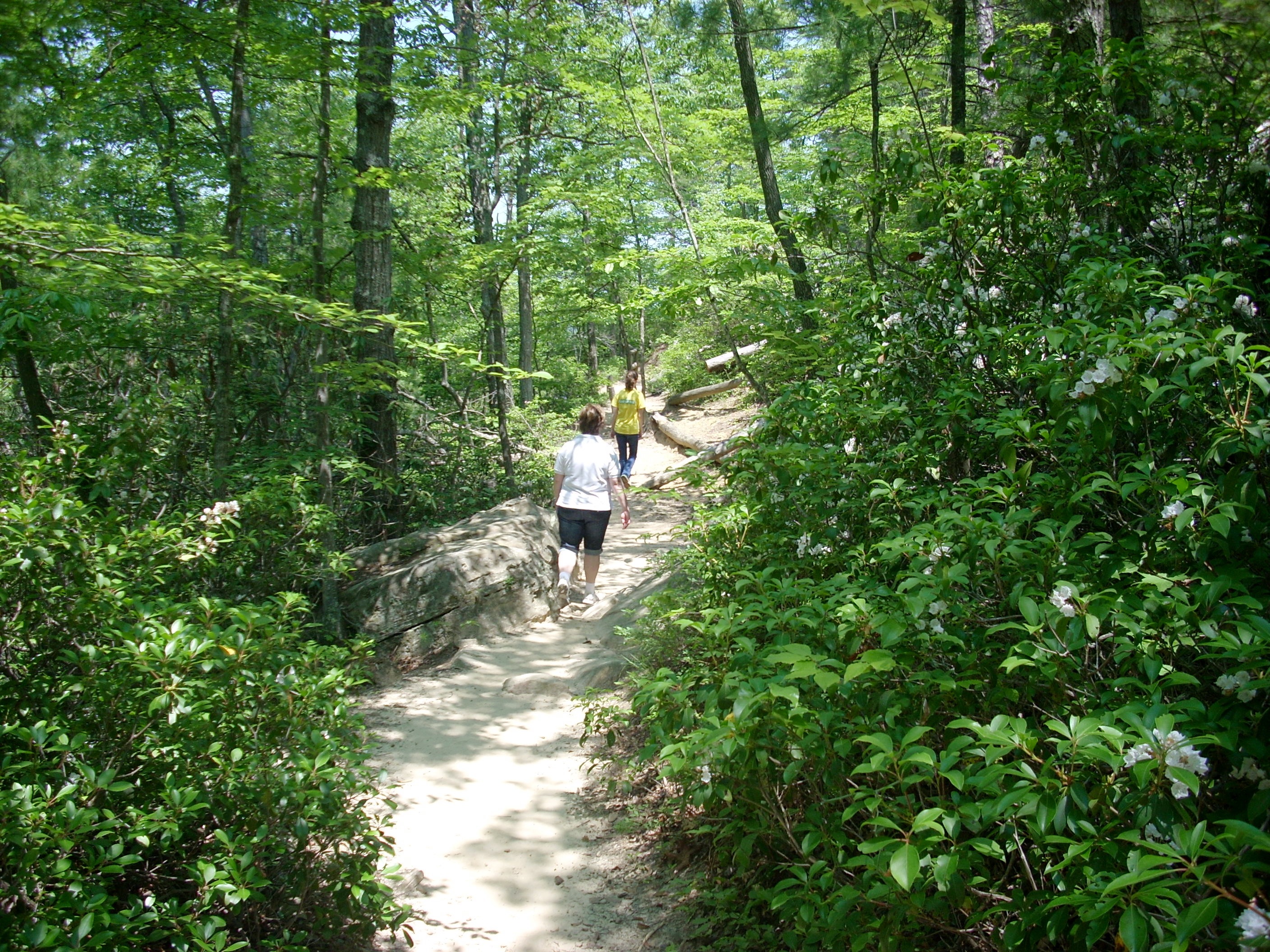 |
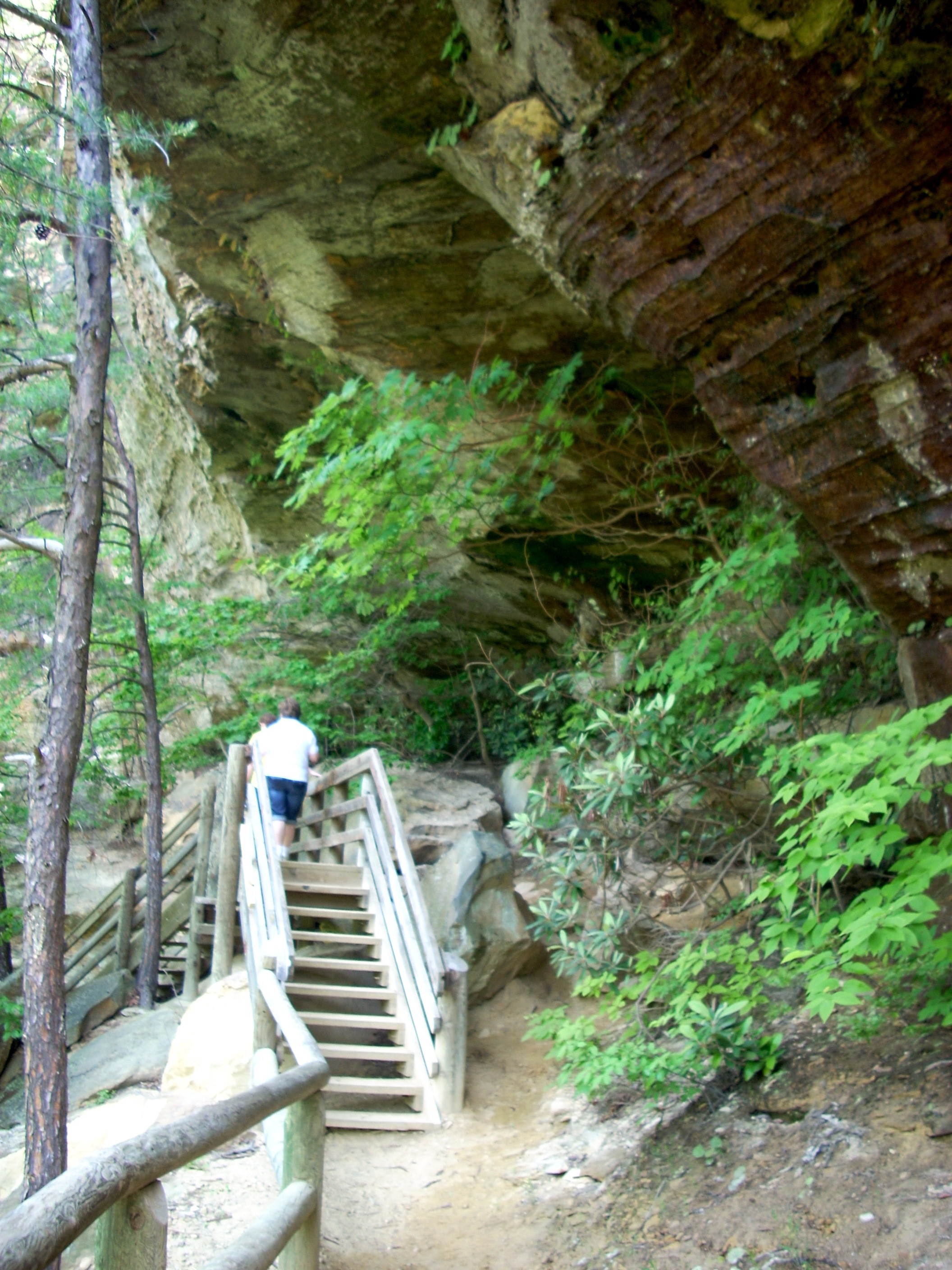 |
As you drop down further along the cliff, you come to this massive rock shelter with several boulders. To get hikers across, this staircase climbs up and down over the boulders. Archaeologists have found evidence of Adena Indians using this rock shelter long before the white men arrived. |
From the staircase above, you can look back across the valley and see this view of Battleship Rock. The Original Trail climbed the hill between these two points. Natural Bridge is to your left in this picture.
|
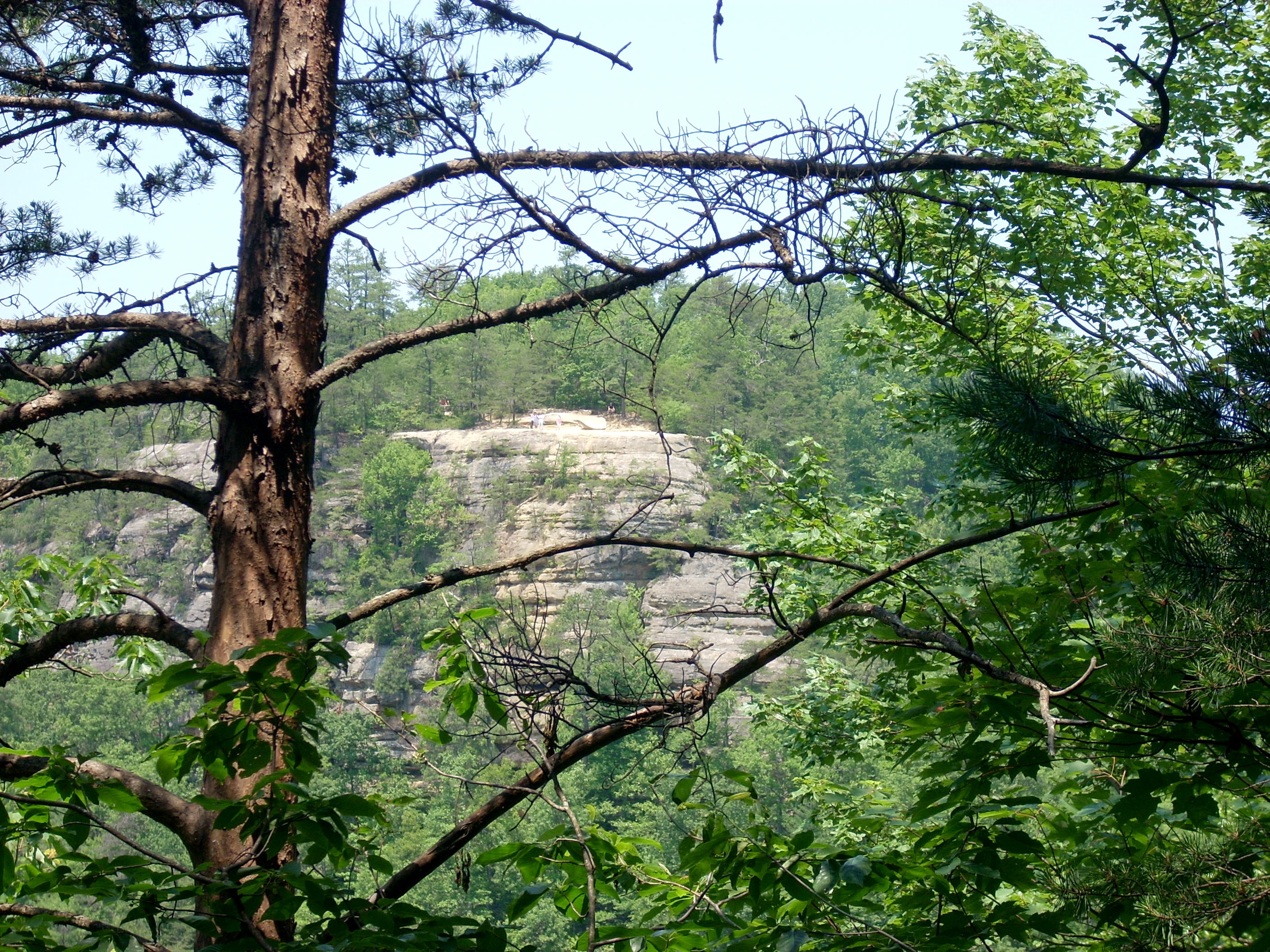 |
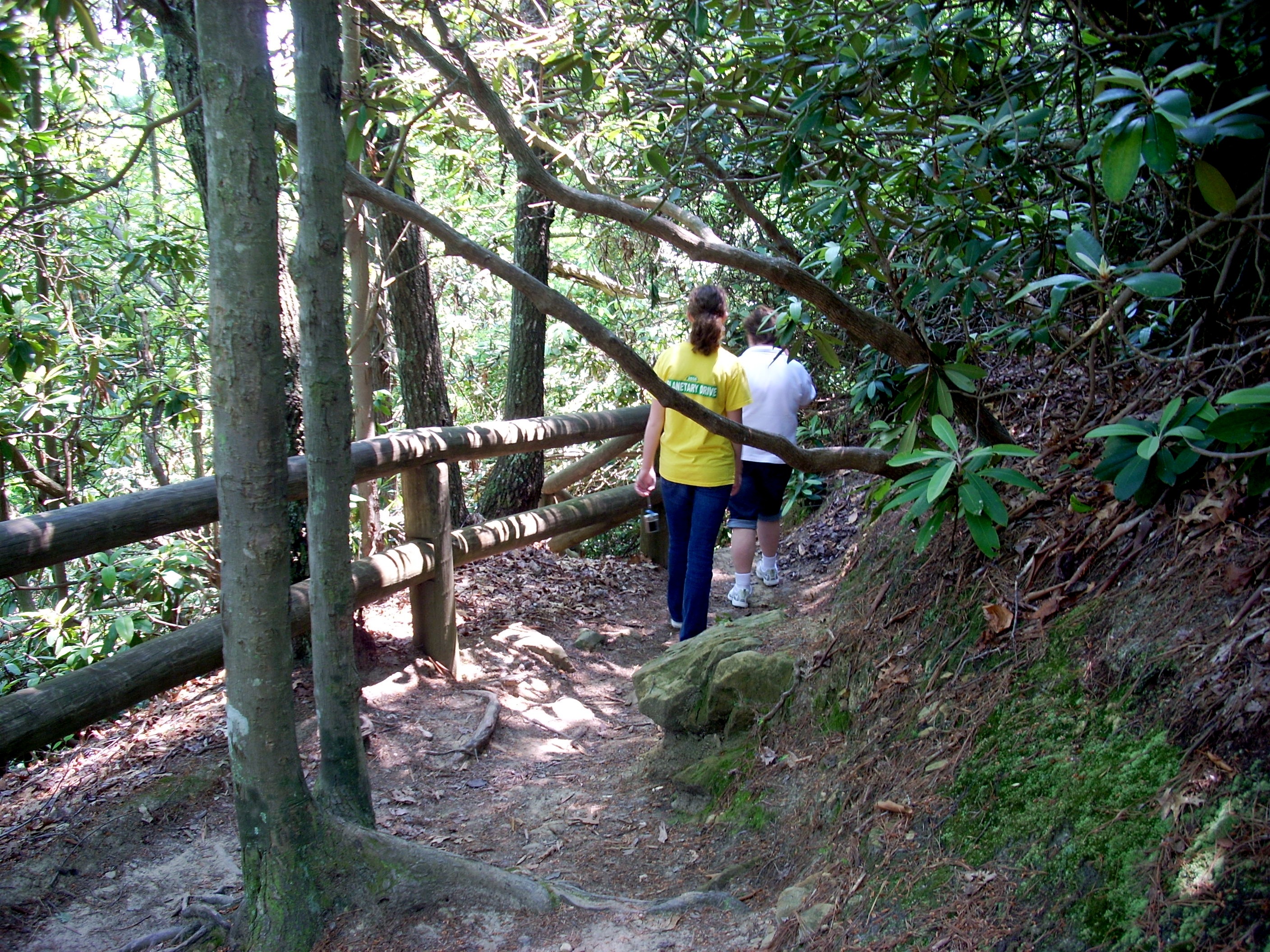 |
By this point the trail is almost tunneling underneath stands of huge Rhododendron trees. In most places, Rhododendron grow as bushes. In the Red River Gorge they grow to tree size, and spread out to create very dense thickets. Hikers often have to duck under low branches. The rail to the left protects hikers from a cliff. It's a long way down to the valley below. |
| Shown here is The Helix, one of the most spectacular staircases on any hiking trail in the country. This photo does not really do the staircase justice. The cameraman is already half way down the stairs, and there is a long section that disappears around the rock to the left. Construction of The Helix is considered one of the greatest engineering feats in the park, and maintaining the staircase in good shape requires attention every Spring. |
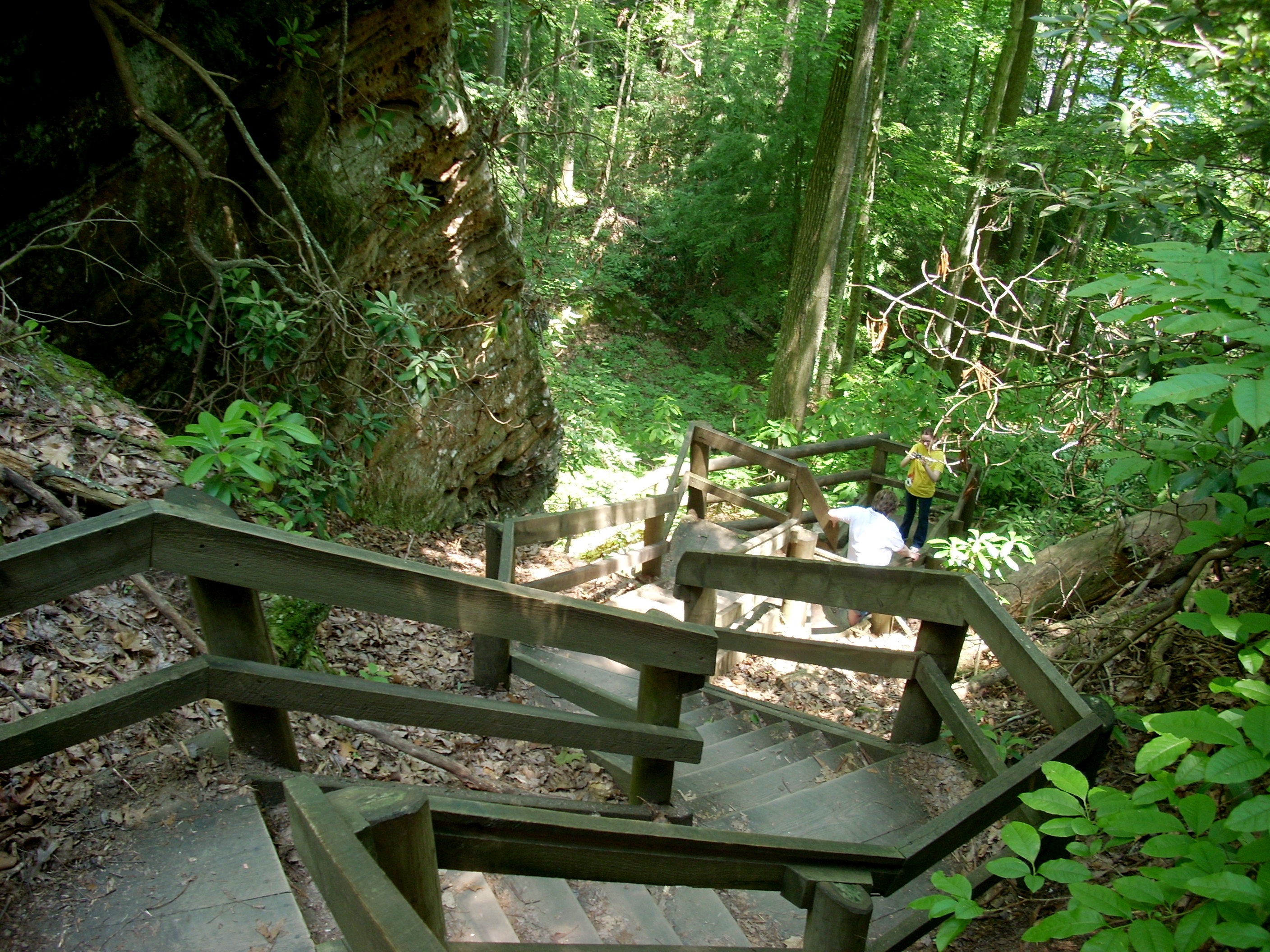 |
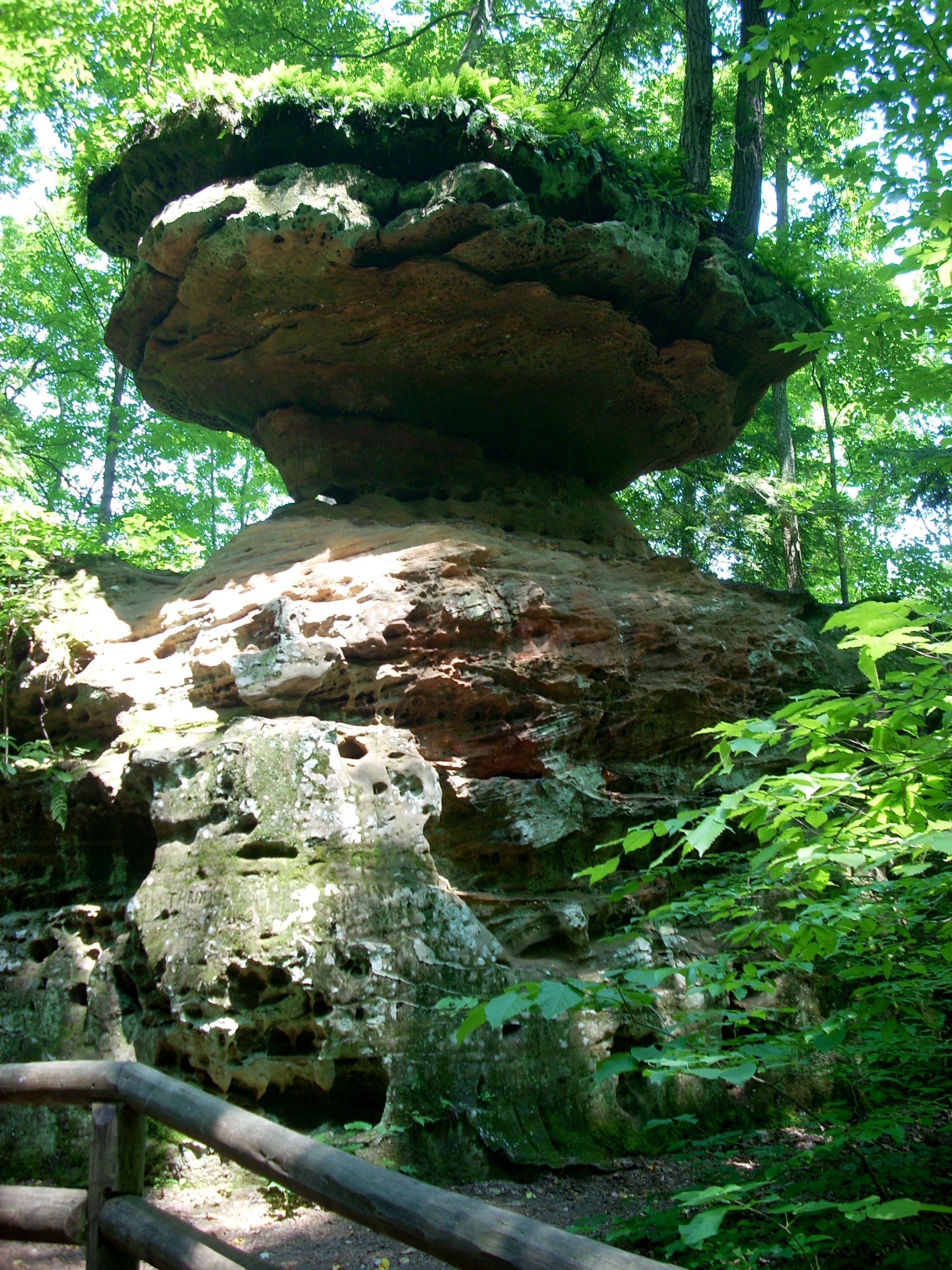 |
A short distance from the bottom of The Helix is Balanced Rock, the trail's namesake rock formation. This is a classic example of Differential Erosion. There is another, larger Balanced Rock on the west side of the park, but because of the difficult terrain the trail over there was abandoned. |
| Huge house sized boulders like this have broken away from the ridgetop and tumbled down to the valley. The trail once it reaches the valley floor winds through many of them. |
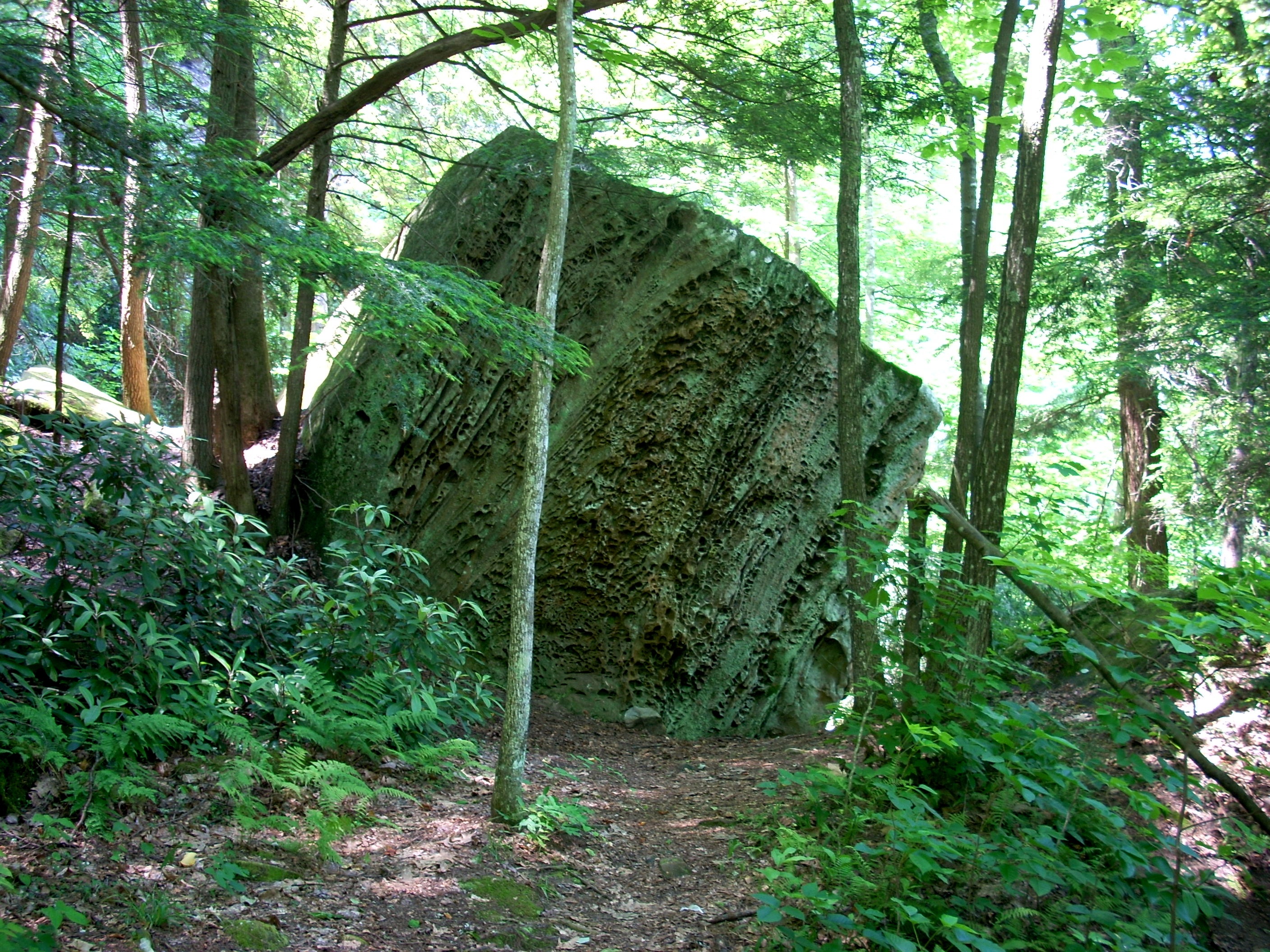 |
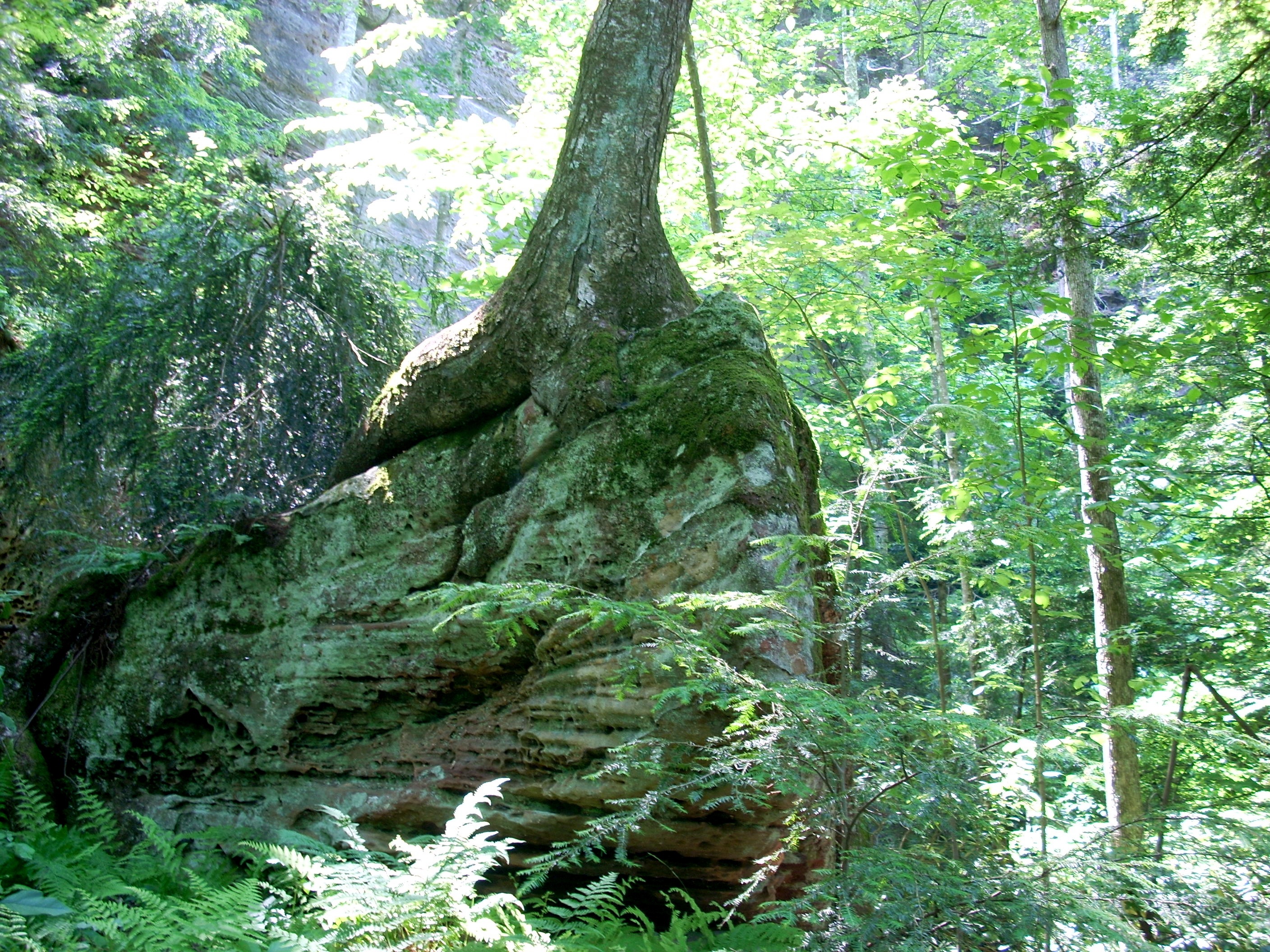 |
One of the more photogenic features of the park are these trees wrapping their roots around the large boulders. Natural Bridge State Park is a photographer's paradise. |
| This is the lower opening to the cave with its upper opening along The Original Trail. Adena Indians frequented this rock shelter and the cave extending back from it. |
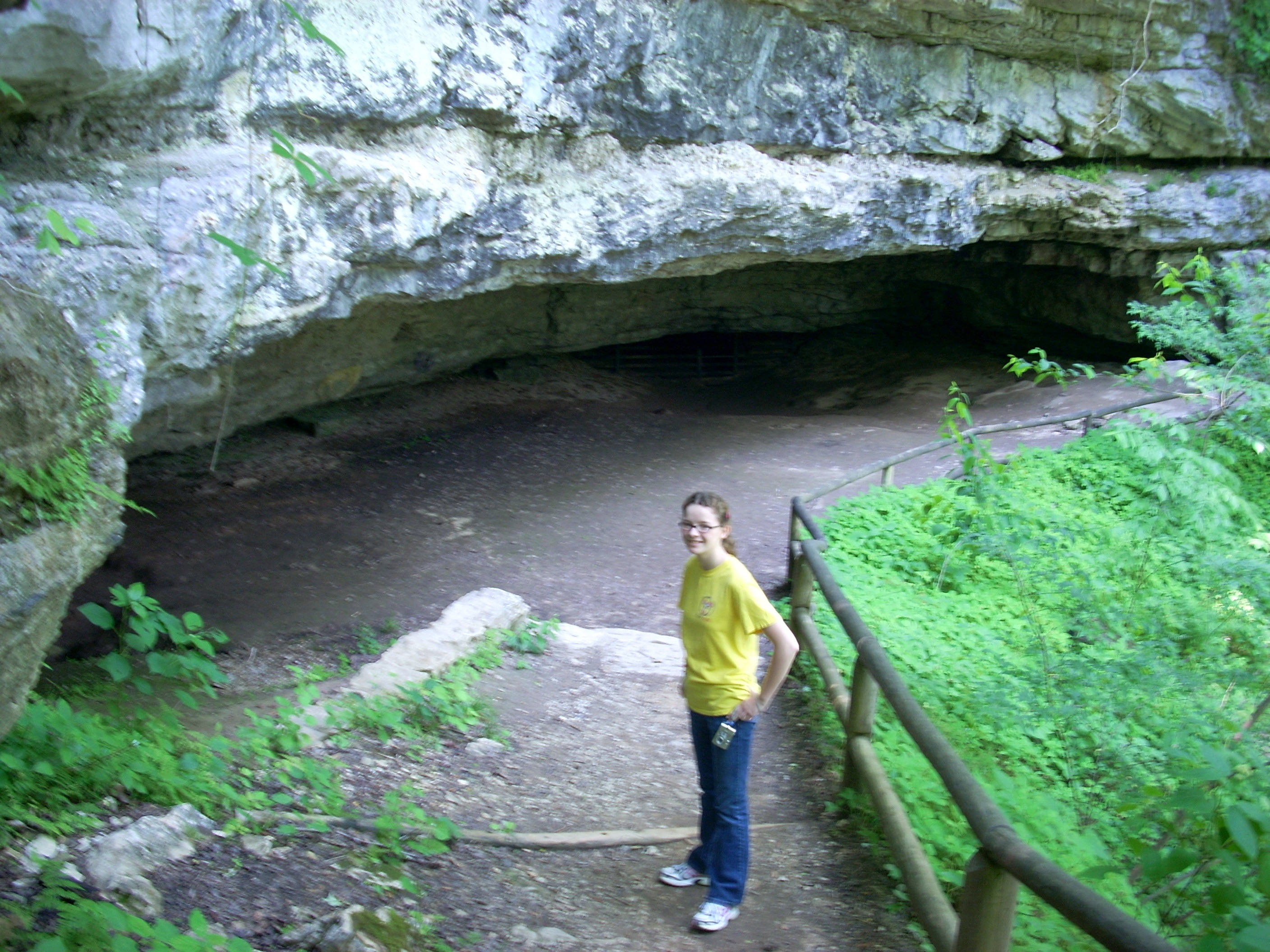 |
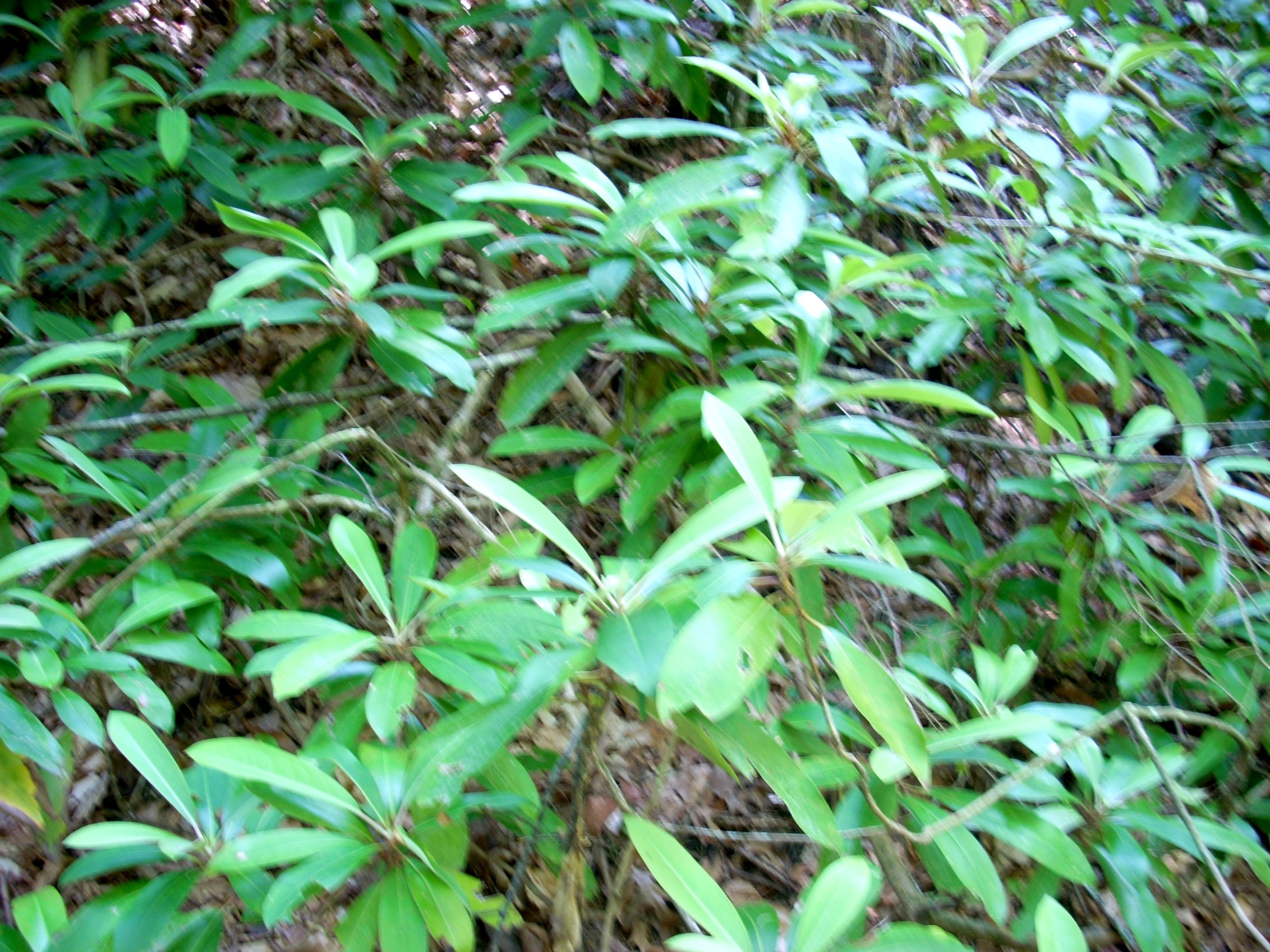 |
Mountain Laurel help Rhododendron create a very dense forest understory. They give the landscape a tropical rainforest appearance. There is also a certain danger here. Unlike more open woods, you cannot see far into this forest. If you wander off the trail, you may not be able to find it again even when you are only 10 yards from it. It is easy to see how animals can hide here, and how long ago the Adena Indians could slip through this forest without being seen. Because so much of Natural Bridge State Park consists of Pine Trees, Mountain Laurel and Rhododendron, the park remains a dense green throughout the Winter. |
|
